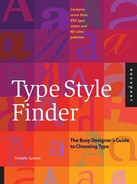
A Type and Color Primer
8
The Differences in the Details
The formal characteristics of every typeface—
the degree of contrast in the strokes, the relative
height of the lowercase, the shapes of terminals
and serifs, the overall width and rhythm of strokes
and counters, and so on—vary considerably from
one to the next. Sometimes these differences
appear quite small, but their overall effect is
a change in presence that, though potentially
subtle, affects the typeface’s feeling and therefore
the associations it may evoke in an audience.
Being able to locate details within different faces
for comparison, as well as understanding how
those details affect thevisual rhythm and feeling
of the face, are important skills to master.
Some important structural details to consider are
highlighted in the collage above; comparison of
the letters among the classified styles, opposite,
will reveal further distinctions.
Typeface Classification
Classifying type into groups can help highlight the differences
among styles, organizing them in a general way and further
helping to select an appropriate typeface for a particular project.
Sometimes the historical or cultural context of a particular style
adds relevant communication to a typographic design. In other
instances, selecting a historical style that is anachronistic to the
project’s context will add a layer of meaning that is appropriate.
Classification is by no means easy, however. Type designers
have traditionally used older forms as a basis for exploration,
and so even centuries ago, classifying a typeface was difficult—
historical references that became the basis of the design process
introduced a certain amount of stylistic overlap from period to
period. With an even greater archive of typographic evolution
on hand today, contemporary type designers often mix and
match qualities from a number of periods to produce hybrids
of classification. The typeface Optima, for example, drawn by
Hermann Zapf in the 1950s, is a sans serif face that exhibits
modulation that could have been derived from a brush, as well
as structural details that are often seen in oldstyle serif faces.
A number of systems for classifying type have been developed
over the past several decades. Nowadays, as then, classifications
change, but a few basic categories remain constant. Knowing
what differences to look for—and where those differences come
from—is a good start to evaluating type styles to carry specific
kinds of messages.
Stroke Terminals
and Spurs
Apertures
Serif Shapes
Joint Variation
Axis and Spine
Beaks
Ductus and
Modulation
Branch Variation
and Counter Shapes
(Provision) Type Style Finder
CD606.006 / 4108
1 TSF_FM_001-015_new.qxd 6/3/06 10:25 AM Page 8

Type Style Finder
9
Oldstyle Characterized by organic contrast of weight
in the strokes—from brush or pen drawing; an angled,
or oblique, axis in the curved forms; and a notably
small x-height defining the lowercase letters. The
terminals are pear shaped and the apertures in the
lowercase letters are small.
Transitional These types show an evolution in struc-
ture. Stroke contrast is greatly increased and more
rationally applied—its rhythm is greatly pronounced.
The x-height of the lowercase is larger; the axis is
more upright; and the serifs are sharper and more
defined, their brackets curving quickly into the stems.
Modern Stroke contrast is extreme—the thin strokes
are reduced to hairlines and the thick strokes made
bolder. The axis of the curved forms is completely
upright, and the brackets connecting the serifs to the
stems have been removed, creating a stark and ele-
gant juncture. The serifs in a number of the lowercase
characters have become completely rounded, reflecting
the logic of contrast and circularity.
Sans Serif These typefaces are an outgrowth of
“display types”of the nineteenth century, designed to
be bold and stripped of nonessential details. They are
defined by a lack of serifs; the terminals end sharply
without adornment. Their stroke weight is uniform,
and their axis is completely upright. Sans-serif types
set tighter in text and are legible at small sizes; during
the past fifty years, they have become acceptable
for extended reading.
Slab Serif Another outgrowth of display types,
slab serif faces hybridize the bold presentation of a
sans-serif and the horizontal stress of a serif face,
characterized by an overall consistency in stroke
weight. The serifs are the same weight as the stems,
hence “slabs;” the body of the slab serif is often wider
than what is considered normal.
Graphic These typefaces are the experimental,
decorative, children of the display types. Their visual
qualities are expressive but not conducive to reading
in a long text. This category of faces includes speci-
mens such as script faces, fancy and complex faces
inspired by handwriting, and idiosyncratic faces that
are illustrative or conceptual.
(Provision) Type Style Finder
CD606.006 / 4108
1 TSF_FM_001-015_new.qxd 6/3/06 10:25 AM Page 9
..................Content has been hidden....................
You can't read the all page of ebook, please click here login for view all page.
